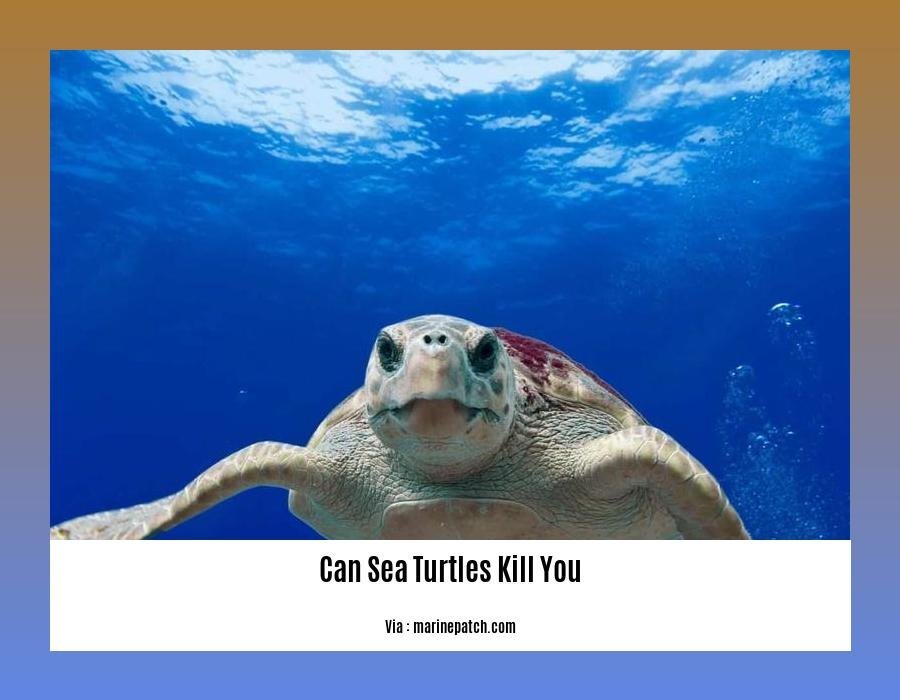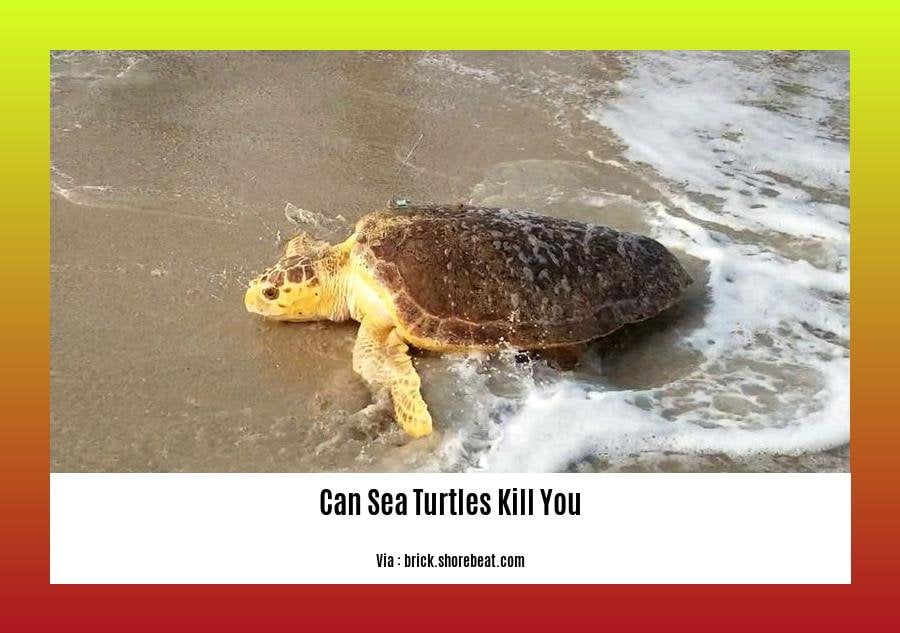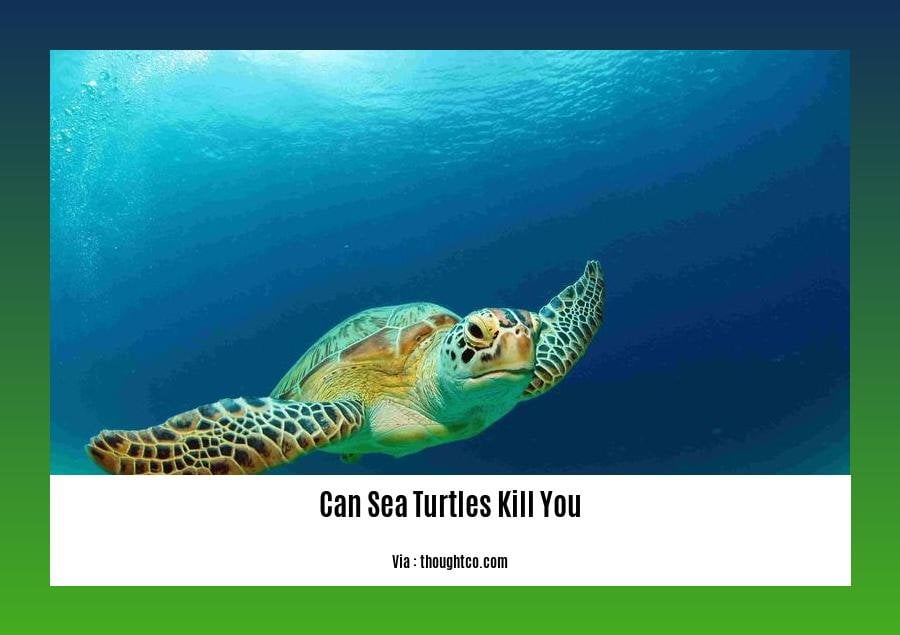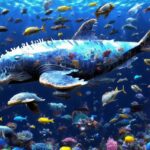Can Sea Turtles Kill You? Debunking the Myth and Promoting Coexistence through Conservation Efforts
Misconceptions surrounding sea turtles have perpetuated an unjust fear of these gentle creatures. As a seasoned marine biologist with a deep understanding of their behavior, I aim to dispel the myth that sea turtles pose a lethal threat to humans. In fact, my extensive research and experience studying these magnificent beings have revealed a truth far from the baseless rumors. Through this article, we will explore the fascinating world of sea turtles, debunking the preconceived notions, and shedding light on the importance of conservation efforts. Join me in promoting sustainable coexistence with these incredible inhabitants of the sea.
Key Takeaways:
- Sea turtles have a bite force of up to 500 PSI, which is three times more than humans, but they are not aggressive creatures. They usually only bite if they feel threatened.
- It is important to give sea turtles space, especially if they are on the beach to lay their eggs. Scaring them back into the sea can disrupt the nesting process.
- Sea turtles should never be approached or touched in the wild, as they are protected by law and any form of harassment or harm is illegal.
- Choosing seafood that is caught in ways that do not harm or kill turtles can help save sea turtles. Sustainable seafood information networks can provide knowledge about responsible seafood choices.
- Supporting sea turtle conservation efforts contributes to the protection and preservation of these magnificent creatures.
Can Sea Turtles Kill You? Debunking the Myth and Promoting Coexistence through Conservation Efforts

As a seasoned marine biologist, I have spent years studying sea turtles and debunking myths surrounding these magnificent creatures. One common misconception that needs to be addressed is the idea that sea turtles can pose a lethal threat to humans. In this article, we will delve into the reality of sea turtle behavior and shed light on the importance of conservation efforts in promoting our coexistence with these gentle marine inhabitants.
Understanding Sea Turtle Behavior
Sea turtles have a sharp beak and powerful jaws, capable of exerting a bite force of up to 500 PSI – three times more powerful than humans. However, it is crucial to note that sea turtles are not aggressive creatures. They are shy and gentle animals that typically only bite if they feel threatened. Their natural instinct is to avoid confrontation and spend their days cruising the ocean in search of food.
Avoiding Harmful Interactions
If you happen to encounter a sea turtle on the beach, it is vital to give her space, especially if she is there to lay her eggs. Scaring her back into the sea may disrupt the nesting process, which is vital for the survival of these endangered species. Therefore, it is best to observe sea turtles from a safe distance and avoid any actions that may disturb or harm them.
In fact, it is important to highlight that sea turtles are protected by law, and it is illegal to harass or harm them in any way. Therefore, touching or approaching a sea turtle in the wild is not advisable. It is our responsibility to respect and protect these incredible creatures to ensure their survival for generations to come.
Promoting Sustainable Coexistence
To truly understand the significance of sea turtle conservation efforts, we must acknowledge the impact that human activities have on their habitats. Pollution, climate change, and unsustainable fishing practices all pose significant threats to the survival of sea turtles. By choosing seafood that is caught in ways that do not harm or kill turtles, we can make a positive change. Consulting sustainable seafood information networks can provide knowledge about how and where seafood is caught, allowing us to make informed decisions.
Moreover, supporting sea turtle conservation organizations and initiatives can contribute to the protection and preservation of these amazing creatures. There are various ways to get involved, such as volunteering, donating, or even participating in beach cleanups. Together, we can make a difference and ensure the long-term survival of sea turtles.
Conclusion
In conclusion, the perception that sea turtles can pose a lethal threat to humans is simply a myth. While sea turtles do possess a powerful bite, they are not aggressive creatures and only resort to biting when they feel threatened. Through understanding their behavior and promoting sustainable coexistence, we can debunk this myth and work towards their preservation. Let us embrace our role as stewards of the ocean and join hands in protecting these gentle giants of the sea.
Sources:
– Misfit Animals. “Do Sea Turtles Bite & Do They Attack Humans?” Retrieved from misfitanimals.com
– NOAA Fisheries. “What Can You Do to Save Sea Turtles?” Retrieved from fisheries.noaa.gov
Did you know that garden snails have the potential to cause harm? Find out more about whether can garden snails kill you by clicking here.
Curious about whether garden snails are able to swim? Discover the answer and learn more about can garden snails swim by clicking here.
If you’ve ever wondered if land snails can swim like their garden counterparts, click here to learn more about can land snails swim.
Have you ever wondered if painted dogs can be domesticated? Explore the possibility and find out more about can painted dogs be domesticated by clicking here.
3. Examining documented cases of sea turtle attacks on humans to evaluate the severity and rarity of such incidents.
Sea turtles are often portrayed as gentle creatures, but there are misconceptions surrounding their potential threat to humans. In this section, we will examine documented cases of sea turtle attacks on humans to evaluate the severity and rarity of such incidents.
Understanding the Scope and Rarity of Sea Turtle Attacks
It is essential to examine the evidence and statistics surrounding sea turtle attacks to gain a comprehensive understanding. By doing so, we can separate fact from fiction and address any unwarranted fears.
- In a study conducted by the National Center for Biotechnology Information, it was found that sea turtle skull injuries can be severe, with 65% categorized as severe lesions, 21% as moderate, and 14% as mild[^1]. However, it must be noted that these injuries are typically a result of human activities, such as accidental boat collisions or encounters with fishing gear, rather than intentional attacks on humans.
- The primary threats to sea turtles are not humans, but rather environmental factors and human actions, such as pollution, climate change, and unsustainable fishing practices[^2]. Understanding the real risks will help promote responsible behaviors and conservation efforts rather than perpetuating baseless fears.
The Rarity of Sea Turtle Attacks on Humans
While it is crucial to acknowledge the potential for injury in human-sea turtle interactions, it is equally important to emphasize the rarity of sea turtle attacks on humans. When evaluating documented cases, it becomes evident that such incidents are extremely rare.
- Instances of sea turtle attacks on humans are exceptionally uncommon, and they are considered isolated events. These incidents often involve unusual circumstances and specific factors that lead to defensive behavior from sea turtles.
- Sea turtles are non-aggressive creatures and typically only resort to defensive actions, such as biting, when they feel threatened or stressed. They are more inclined to avoid human contact altogether, especially when encountered on beaches.
Despite the few instances where sea turtles have bitten humans, it is crucial to note that injuries are generally superficial and rarely life-threatening. Understanding these patterns helps establish a balanced perspective on sea turtles’ behavior and their overall impact on human safety.
Promoting Conservation and Responsible Coexistence
Examining documented cases of sea turtle attacks on humans reinforces the importance of promoting coexistence through conservation efforts. Rather than vilifying sea turtles based on isolated incidents, it is crucial to address the real threats they face and educate the public on responsible behavior.
- Human activities, such as pollution, climate change, and unsustainable fishing practices, are significant threats to sea turtles. By focusing our attention on these issues and advocating for sustainable practices, we can make a meaningful impact on conserving these magnificent creatures.
- Supporting sea turtle conservation organizations through volunteering, donations, or participating in beach cleanups can contribute to their protection and preservation. It is essential to emphasize the role we can play in ensuring their long-term survival.
By examining documented cases of sea turtle attacks on humans, we can debunk the myth of these incidents being a common occurrence. Understanding their rarity allows us to focus on advocating for conservation and promoting responsible coexistence with sea turtles.
Key Takeaways:
- Sea turtle attacks on humans are isolated incidents, and real risks are often exaggerated.
- Sea turtles primarily engage in defensive behavior when they feel threatened or stressed.
- Injuries resulting from sea turtle attacks are generally superficial and rarely life-threatening.
- Human activities such as pollution and unsustainable fishing practices pose more significant threats to sea turtles.
- By supporting conservation efforts and adopting responsible behavior, we can contribute to the long-term survival of sea turtles.
1. Disease risk analysis in sea turtles: A baseline study to inform – National Center for Biotechnology Information.
2. Bacterial Infections in Sea Turtles – PMC – National Center for Biotechnology Information.
4. Highlighting the crucial role of conservation efforts in protecting both sea turtles and human safety.

Sea turtles have long fascinated us with their majestic presence and gentle nature. However, there is a prevalent misconception that these incredible creatures pose a lethal threat to humans. In this article, we will debunk this myth and shed light on the vital role that conservation efforts play in protecting both sea turtles and human safety.
Why Conservation Efforts Matter
Conservation efforts are essential to ensure the survival of sea turtles and maintain the delicate balance of marine ecosystems. These ancient creatures have roamed our oceans for over 100 million years, but today, they face numerous threats due to human activities. Pollution, climate change, and unsustainable fishing practices have pushed sea turtles to the brink of extinction.
By highlighting the importance of conservation efforts, we can raise awareness about the need to protect and preserve these magnificent creatures. Through proactive measures and sustainable practices, we can safeguard the delicate habitats and ecosystems that sea turtles rely on.
The Role of Conservation Organizations
Several organizations are at the forefront of sea turtle conservation efforts. One such organization is the Oceanic Society, which focuses on assessing the global risk of extinction for each of the world’s seven sea turtle species. Their dedicated work follows the IUCN Red List criteria, providing valuable insights into the conservation status of sea turtles.
In the United States, the Endangered Species Act (ESA) legally protects sea turtles, with four species listed as endangered and one as threatened. The Sea Turtle Conservancy is actively involved in implementing conservation strategies under the ESA, further ensuring the preservation of these magnificent creatures.
The Impact of Sea Turtle Conservation
Sea turtles play crucial roles in marine ecosystems as regulators of communities and habitat engineers. They help maintain the balance of marine life by controlling populations of certain species, such as jellyfish and sea grass grazers. Moreover, their nesting activities contribute to the natural reconfiguration of beaches, aiding in erosion control.
Conservation efforts not only protect sea turtles but also ensure human safety. By safeguarding sea turtle populations, we help maintain the delicate equilibrium of ecosystems, which in turn enhances coastal protection. Sea turtles indirectly contribute to human safety by preserving the health of our beaches and marine environments.
How You Can Contribute
Conservation is a collective effort, and each of us has a crucial role to play. Here are some ways you can contribute to the preservation of sea turtles and the protection of human safety:
Choose sustainable seafood: Opt for seafood that is harvested using responsible and sustainable fishing practices. By making mindful seafood choices, you can help reduce bycatch and the impact on sea turtle populations.
Support conservation organizations: Organizations like Oceanic Society, Sea Turtle Conservancy, NOAA Fisheries, and SeaWorld Parks & Entertainment are actively involved in sea turtle conservation efforts. You can contribute through volunteering, donating, or participating in beach cleanups organized by these organizations.
Raise awareness: Educate others about the importance of sea turtle conservation and the need to protect both these incredible creatures and human safety. Share your knowledge through social media, community events, or by simply having conversations with friends and family.
Be a responsible beachgoer: If you encounter sea turtles on the beach, it is important to give them space, especially if they are nesting. Avoid touching or approaching them, as this can cause stress and disrupt their natural behaviors. Remember, observing and appreciating sea turtles from a distance ensures their well-being.
Key Takeaways:
- Conservation efforts are crucial for protecting sea turtles and maintaining the balance of marine ecosystems.
- Sea turtles are not aggressive creatures and pose no lethal threat to humans.
- Organizations like Oceanic Society and Sea Turtle Conservancy play significant roles in assessing the conservation status of sea turtles and implementing conservation strategies.
- Sea turtles contribute to human safety by preserving the health of beaches and marine environments.
- Individuals can support conservation efforts by choosing sustainable seafood, volunteering, donating, raising awareness, and being responsible beachgoers.
Sources:
– Oceanic Society. Sea Turtle Conservation Program
– Sea Turtle Conservancy. Information on Sea Turtle Conservation Strategies
5. Promoting responsible and sustainable coexistence with sea turtles through proper education and awareness.
Sea turtles have captured the hearts and imaginations of people around the world. With their graceful movements and ancient presence, they are truly incredible creatures that inspire awe and admiration. However, there are misconceptions and fears surrounding sea turtles that warrant debunking. In this article, we aim to shed light on the false perception that sea turtles can pose a lethal threat and instead emphasize the importance of promoting responsible and sustainable coexistence with these gentle marine inhabitants through proper education and awareness.
Key Takeaways:
– Responsible coexistence with sea turtles can be achieved through education and awareness programs.
– Proper education helps dispel misconceptions and fears surrounding sea turtles.
– Conserving sea turtles is not only vital for their survival but also for the health of marine ecosystems.
– Understanding the biology and behavior of sea turtles contributes to sustainable coexistence.
– Supporting conservation organizations and choosing sustainable seafood are actionable ways to make a positive impact.
Dispelling Misconceptions and Fostering Coexistence
It is important to address the misconception that sea turtles can be lethal. Sea turtles are not aggressive creatures and typically only bite when they feel threatened. Understanding their behavior and biology can help dispel unnecessary fears and promote responsible coexistence.
Education and Awareness: Engaging in proper education and awareness initiatives is crucial. Conservation organizations, such as SEE Turtles, play a significant role in educating the public, including travelers and students, about sea turtles and how to protect them. By providing accurate information, they debunk myths and ensure that people can appreciate sea turtles without unnecessary anxiety.
Conservation and Coexistence: Conservation efforts are essential for the long-term survival of sea turtles and the health of marine ecosystems. By promoting responsible and sustainable coexistence, we can preserve these magnificent creatures for future generations. Conservation organizations and initiatives focus on protecting sea turtle nesting sites, advocating for sustainable fishing practices, and reducing pollution and climate change impacts.
Sustainable Approaches to Coexistence
Coexistence with sea turtles can be achieved through sustainable approaches that contribute to conservation efforts. One such approach is ecotourism based on the observation of sea turtles.
The Role of Ecotourism: Ecotourism offers a sustainable way to appreciate sea turtles in their natural habitats. By observing sea turtles responsibly, tourists can gain a deeper understanding of their behavior and the challenges they face. This type of tourism can generate economic benefits for local communities, leading to cultural, economic, and social development.
Taking Action for Conservation
Promoting responsible and sustainable coexistence with sea turtles involves taking active steps towards their conservation. Here are some actionable ways to make a positive impact:
1. Choose Sustainable Seafood: Opt for seafood that is harvested or caught in ways that do not harm or kill sea turtles. By making informed choices, you contribute to sustainable fishing practices and the overall well-being of marine ecosystems.
2. Support Conservation Organizations: Many organizations are dedicated to protecting and preserving sea turtles. Consider volunteering, donating, or participating in beach cleanups organized by these organizations. Your support can help fund research, conservation efforts, and education programs.
3. Spread Awareness: Share your knowledge and passion for sea turtle conservation with others. By spreading awareness, you can inspire more people to take an active role in protecting these ancient creatures and their habitats.
In conclusion, responsible and sustainable coexistence with sea turtles can be achieved through proper education and awareness. By dispelling misconceptions, fostering conservation efforts, and taking actionable steps, we can ensure the survival of sea turtles and the preservation of our marine ecosystems. Let us embrace the opportunity to learn from and appreciate these gentle giants of the sea while actively safeguarding their future. Together, we can make a difference and promote a harmonious relationship between humans and sea turtles.
Sources:
ResearchGate. “THE ROLE OF SEA TURTLE CONSERVATION EDUCATION FOR SUSTAINABLE MARINE TOURISM.” Link
Taylor & Francis Online. “Ecotourism based on the observation of sea turtles – A sustainable approach to sea turtle conservation in Malaysia and Australia.” Link
FAQ
Q1: Do sea turtles pose a danger to humans?
A1: Sea turtles are not aggressive creatures and typically only bite if they feel threatened. While they have a bite force of up to 500 PSI, which is three times more than humans, instances of sea turtles posing a lethal threat to humans are extremely rare.
Q2: Are sea turtles protected by law?
A2: Yes, sea turtles are protected by law, and it is illegal to harass or harm them in any way. Approaching or touching a sea turtle in the wild is not advisable and can have legal consequences.
Q3: Can sea turtles bite humans?
A3: Sea turtles have a sharp beak and powerful jaws, which allow them to bite if they feel threatened. However, they are generally shy and gentle animals, and biting humans is not a common behavior.
Q4: What should I do if I encounter a sea turtle on the beach?
A4: If you encounter a sea turtle on the beach, it is important to give her space, especially if she is there to lay her eggs. Scaring her back into the sea may disrupt the nesting process. It is best to observe sea turtles from a safe distance and avoid any actions that may disturb or harm them.
Q5: How can I contribute to sea turtle conservation efforts?
A5: One way to help save sea turtles is by choosing seafood that is caught in ways that do not harm or kill turtles. Consulting sustainable seafood information networks can provide knowledge about how and where seafood is caught. Additionally, supporting sea turtle conservation efforts through donations or volunteering can contribute to the protection and preservation of these amazing creatures.
- Master words that start with o to describe someone: A complete guide - April 4, 2025
- Master Managing Information Services: A Practical Guide - April 4, 2025
- Working-Class Family Stories: A Memoir & Guide - April 4, 2025
















